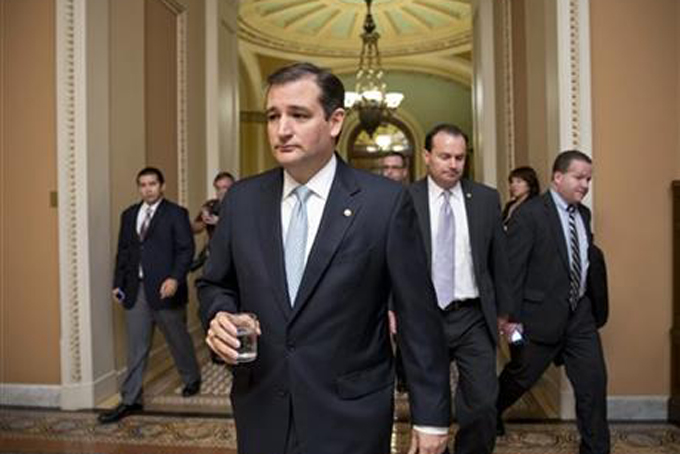
In this Wed., Oct. 16, 2013 file photo, Tea party conservatives Sen. Ted Cruz, R-Texas, and Sen. Mike Lee, R-Utah, right, walk to a meeting as the Senate prepares to vote on a measure to avert a threatened Treasury default and reopen the government after a partial, 16-day shutdown, at the Capitol in Washington. (AP Photo/J. Scott Applewhite, File)
In May, U.S. Sen. Harry Reid, D-Nev., called Sen. Ted Cruz, R-Texas, a “schoolyard bully. He pushes everybody around … and instead of playing the game according to the rules, he not only takes the ball home with him but changes the rules. That way, no one wins, except the bully.”
Cruz responded: “The Senate is not a schoolyard setting.” He added: “Speaking the truth … is not bullying.”
More cries of “bully” were directed at Washington during the government shutdown. Accusers included Cindy Waitt, producer of the emotional documentary, “Bully,” about kids tormented to the point of suicide. In a Huffington Post essay, Waitt wrote: “The tactics being used by the ‘shutdown’ gang are textbook bully tactics.”
But not everybody thinks that political clashes — even extreme ones — qualify as bullying.
“Politics is at times confrontational,” said Dan Holler, spokesman for Heritage Action, sister organization to the Heritage Foundation, a conservative think tank. “When those confrontations happen, it’s not a matter of bullying. It’s a matter of trying to litigate policy.”
BULLIES ON THE JOB?
Dr. Harold Pass chairs a committee that evaluates allegations of disruptive behavior at Stony Brook University Medical Center in New York. He says “bullying” accurately describes workplace situations where someone is targeted by a fellow employee — whether it’s a doctor trying to make another one look bad or a nurse targeted by a superior.
“Bullying means intentionality,” Pass said. “If a football team happens to win by a large score, it doesn’t mean the players intended to denigrate, hurt, humiliate, damage or diminish the other team. But that does occur in workplace situations all the time — in hospitals, in factories and corporations, as well as in schools. Any place there’s a power differential, where someone puts other people down, where it’s done willfully, not randomly or unconsciously, that could be bullying.”
Some conflicts in the workplace are more easily defined as harassment rather than bullying. “Bullying is a lot more volitional,” Pass said. “People can make offhanded comments that are disrespectful,” but unless an individual is repeatedly targeted, it may not constitute bullying.